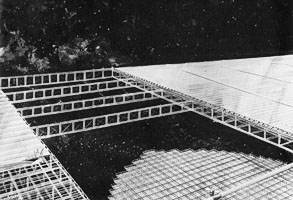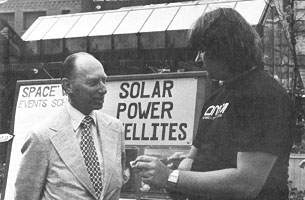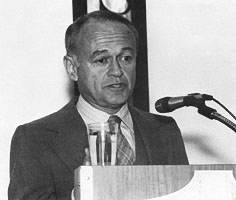by Frederick Osborn, Jr.
From L5 News, February 1981
The DOE/NASA Program Assessment Report — Statement of Findings on its Satellite Power System Concept Development and Evaluation Program was presented to more than 50 representatives of the media at a press briefing organized by an Ad Hoc Coordinating Committee on Space on December 3 at the National Press Club, Washington, D.C.

Artist’s concept of a Satellite Solar Power Station (SSPS) during assembly in low earth orbit (LEO). A beam crawler completes emplacement of a panel’s solar cell blankets and concentrators. The microwave transmission antenna (bottom right) is 900 yards in diameter. (Courtesy NASA)
Dr. Jerry Grey, Administrator of Public Policy, American Institute of Aeronautics and Astronautics, introduced Dr. Peter E. Glaser, Vice President of Arthur D. Little. Inc. and president of SUNSAT Energy Council, who presented an overview of the report and answered questions for more than an hour and a half.
The report, Dr. Glaser said. is the culmination of a three year $19.5 million study by the Department of Energy, the National Aeronautics and Space Administration, the Environmental Protection Agency, the Department of Commerce, and more than 60 organizations, including public interest and small consulting groups as well as universities and large industrial firms.
The report is a landmark document, he said. It represents the first time in the history of assessing energy options that a major technology has been reviewed so carefully prior to its application. It sets a pattern for future assessments of major technologies.
While the report presents no conclusions or recommendations, its findings are positive for further exploration of the SPS concept. No “show stoppers” or insurmountable obstacles to bringing power from space down to the Earth’s surface were found.
Because of the significance of these findings to future energy supplies, to public understanding of SPS, and to futture space activities, an ad-hoc Coordinating Committee on Space, comprised of the Aerospace Industries Association, the American Astronautical Society, the American Institute of Aeronautics and Astronautics, the L-5 Society, the National Space Institute, the Space Foundation and SUNSAT Energy Council was formed to organize the press briefing, to publicize the key findings and to present conclusions and recommendations.
Dr. Glaser selected the following highlights:
• The reference system developed by NASA for the study (a 10×5 km satellite using photovoltaic or thermal collectors to feed a 2.45 GHz transmitter using klystrons and delivering 5 GWe to utility grids on the earth via a 10×13 km receiving antenna) uses only known technology and is amenable to evolutionary development. Solar Power Satellites appear to be not only technically possible, but also subject to technical improvement. For example, advanced concepts with improved technology, developed only 2-1/2 years after the reference system was evolved, project a capital cost reduction from the reference system estimate of $3000 per kilowatt to $1500 per kilowatt.
• No environmental effects were identified as clearly irreducible and unacceptable, including microwave and non-microwave health, ecological, atmospheric and communication effects.
• No insurmountable problems of providing materials or finding land for receiving antennas were uncovered, although some additional manufacturing capacity will be required. Net energy analysis indicates that the SPS energy ratio is very favorable compared with that of fossil and nuclear energy options if fuel requirements are included.
• Government regulations, private sector interface, electricity pricing, industry and labor relocations, financing, and the role of federal and state agencies in land use and energy planning will require further clarification.
• The DOE study has made a great contribution to the knowledge of microwaves. During the next decade the United States and the international community can be expected to agree on microwave exposure standards. When the standards are set the microwave flux in the vicinity of a receiving antenna could be controlled to meet such standards.
• Lloyd’s is already insuring business satellites. As insurance consortiums become more familiar with satellite operations, SPS ground and space risks may become insurable.
• The COMSAT/INTELSAT organization, which now includes 102 countries, is a precedent for the type of international cooperation on the global energy option provided by SPS. A similar organization could be acceptable to both developed and developing countries, sharing costs, distributing benefits widely, preventing military use of SPS and minimizing vulnerability to attack.
• Solar Power Satellites, by opening up a new and very large energy resource, provide opportunities for improving international relations on a global basis.
• The Department of Energy’s Solar Power Satellite Project Division has pioneered in reaching out to uncover possible areas of public concern and has recognized the public’s legitimate role in the decision process. Both advocates and opponents agree that many of the impacts of the SPS program require further study.
• The life cycle cost of solar power satellites is competitive with coal, nuclear and terrestrial photovoltaics. Each alternative technology will have its distinct health and safety impacts and the low level and delayed impacts of all technologies will he hard to assess. The total amount of land required for the complete fuel cycle is roughly the same fur all technologies, but SPS and terrestrial photovoltaics for base-load (centralized) power require large contiguous land areas.
• Space is not owned by the U.S. or by any other country. There is a great demand for positions on the geosynchronous orbit. This could burden SPS with international regulations that may not limit other technologies.
On the basis of the DOE / NASA assessment findings the ad-hoc Coordinating Committee on Space concludes that:
No technical, economic, environmental, societal, or other constraint has been identified which would preclude continuation of an SPS R&D program.
Technical advances, with consequent cost reductions in components and in space transportation can increase the technical feasibility and economic viability of power satellites beyond that of the SPS Reference System. SPS is not critically dependent on any specific technology, which increases confidence in the concept.
International interest, as expressed in studies on SPS being conducted in Canada, England, France, Japan, USSR, ESA, and the United Nations Committee on the Peaceful Uses of’ Outer Space, and work by the scientific and technical community in Austria, Italy, West Germany and India indicate that the SPS is not solely a U.S. program. It has the potential for base load power generation on a global scale, and in addition, represents an evolutionary direction for expanding human activities in space.
Dr. Glaser reported that the ad-hoc Committee recommends:
1. Continuation of the SPS research and study program.
2. Continued ground-based experiments to explore appropriate technologies to acquire the knowledge by which a series of time-phased decisions on the SPS program can he made.
3. Funding for the SPS R&D program should be at a level of $30 million a year for the next five years, with its focus on the SPS, although generic R&D on diverse technologies and discrete issues carried out by federal agencies could contribute to such a program.

Dr. Peter Glaser, left, father of the Solar Power Satellite concept, takes SPS to the street during Spacefair ’79. (File photo.)
Dr. Glaser concluded with his belief that now is the time to explore the possible contribution of the SPS concept to meet the U.S. and the world’s future energy demands. “It is our responsibility to future generations,” he said, “to bring the research on the SPS to its logical conclusion and, in concert with other nations, decide whether or not to proceed with the development of this major energy option.”
In opening the briefing for questions, Dr. Grey reported that studies of SPS by the National Academy of Science and the Congressional Office of Technology Assessment have also been under way over the past three years and that these two organizations will be reporting their findings in the next few months.

Dr. Jerry Grey, Administrator of Public Policy, American Institute of Aeronautics and Astronautics. (Photo by Charles J. Divine).
The first question asked for clarification on the number of satellites and receiving stations. Dr. Glaser replied that the reference system mentions 60, producing a total of 300 GWe, but that to say today how many stations will be provided is presumptive. The 60 stations is not a plan, but an arbitrary reference for study and discussion. To build 300 GWe generating capacity will cost about $1 trillion whatever source of energy is used, whether solar power from space, fossil fuel or nuclear. Dr. Grey said that competition will determine how many satellites will be built.
Dr. Glaser was asked whether power from SPS could be delivered directly to homes, like television broadcasting from communications satellites. He replied that SPS will probably deliver power appropriate to a wide range of situations.
When asked whether geosynchronous orbit was getting too crowded to accommodate solar power satellites Dr. Glaser said that in 100 years, at the present rate of expansion, the orbit would be packed solid, that long before 100 years it will be necessary to agglomerate satellite functions onto large multi-purpose platforms. Large SPS’s could orbit between these platforms.
Asked about possible scarcity of materials, Dr. Glaser said more manufacturing capacity for photovoltaic cells was needed, but that the cells are made of common materials which are in ample supply. There may be shortages of materials for some parts of the satellite system, but substitutes can probably be found. As regards making 1-1/2 billion dipoles for receiving antennas, Dr. Grey said a Japanese friend had told him “give us an order and we’ll deliver in six months.”
When asked about making SPS from lunar materials Dr. Grey replied that it would probably not be done in the early stages, but ultimately, yes, it would be cheaper.
Dr. Glaser was asked whether it is wise to concentrate so much power in one organization. He replied that we will have to learn to handle large institutional projects, and that new arrangements may be necessary, that the U.N. might help, and that the COMSAT/ INTELSAT organization is a good precedent.
Dr. Grey was asked what the $30 million for R&D recommended by the ad-hoc Committee would be spent on. He said he could go through the shopping list, which is long, and available in many places, but did not feel it necessary at this time. He gave as one example for further research: determining the upper limit of microwave density which can be tolerated by the ionosphere.
Frederic Golden from Time magazine asked why no one from DOE was present. “Ask DOE” said Dr. Grey.
Dr. Grey was asked whether all the energy collected in space would have to be beamed down to the Earth. He replied that SPS was a first step in the industrial use of space, and that the energy up there is by no means limited to Earth surface use.
Asked about the present status of the DOE /NASA SPS program, Dr. Grey said it is presently dead. DOE has zero funds from now to October ’81. Congress, however, may act and it is just possible that additional funds could be provided.
“What’s the problem?” Dr. Grey was asked.
“The Administration Program is separate from Congress” he replied, “and SPS has slipped into the crack between them.”
“Should the U.S. pay most of the R&D on SPS?” was another question, to which Dr. Glaser replied that the U.S. should foot the bill for the next five years, after which other countries should participate.
“Isn’t the International Telecommunications Union cool to the idea of SPS?”
“The Third World nations distrust us,” said Dr. Glaser. “We must workwith them.”
“Will Reagan be more receptive than Carter to SPS?”
“No indication as yet. Thirty million is a very small amount compared with some DOE budgets. The transition team has not reached down so far as yet.”
“Will power from satellites cost $5000 per kilowatt to build?”
“The first unit may cost about $2400 per kilowatt in 1980 dollars, later ones $1500 per kilowatt. This is very much within range of alternate sources of energy.”
“How transferable is SPS to military use? Will the intense beams be weapons’? How can suspicion be overcome?”
“‘To answer the last first” said Dr. Glaser, “SPS should be an international project, not a unilateral project of the U.S. or U.S.S.R. Because of its size it would be too vulnerable to be dependable as a weapon (although probably because of its distance from Earth it would be less vulnerable than Earth based plants). The proposed microwave beam is not intense enough to do serious damage.” Dr. Grey added that SPS could be used as a weapon, but no one would build it as one, and that if there are doubts about its use an internatonal inspection team could be assigned to it.
“How much will the U.S.S.R. and Japan do?”
“There is a description of the Soviet program in the April or May issue of New Scientist. The Soviets have agreed that if they build an SPS it will be subject to the 1967 Treaty on the Peaceful Uses of Outer Space. Three papers on microwave power transmission by Japanese authors were presented at the recent IAF Congress in Tokyo. There is considerable interest in West Germany and France at CNES. At a three day Conference on SPS held in Toulouse last June there were 120 participants, of which only 12 were Americans.”
“How soon will there be a demonstration in orbit?”
“Probably not until 1990. It will need room on the Space Shuttle.”
“How about industrial interest? Will it become more aggressive?”
“Industry is very much involved, especially aerospace companies such as Rockwell, Boeing, Grumman, Lockheed, G.E. and others. Industries in Japan are interested.”
By this time the hour of lunch had come, all of the available handouts were gone and discussion continued informally. One of the discussions resulted in a full page illustrated description of an SPS system in the December 15, 1980, issue of Time magazine.






